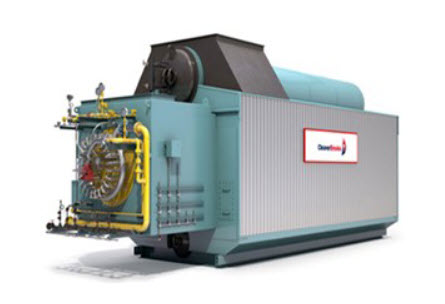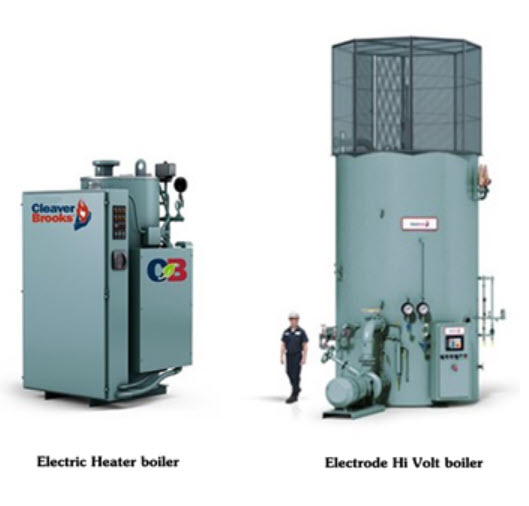Understanding Boilers Used in Business and Industry
Steam Boiler is a machine that transfers heat to the water inside the boiler, converting it into steam. Most industries produce only saturated steam, which is transferred through pipes to machinery so that the heat of the steam can be used for heating or for manufacturing various products. The use of saturated steam in heat transfer processes maintains a constant temperature along the length of the machinery, ensuring consistent product quality and reducing damage compared to using electric heaters, which cause temperature fluctuations. Additionally, purchasing large amounts of electricity is significantly more expensive compared to using fuel to produce steam.
Therefore, boilers are commonly used in hospitals, hotels, and various industrial plants. Boilers come in many designs and types, suited to each specific application or according to the steam production conditions or the type of fuel used to produce steam.
Types and Working Principles of Boilers
1. Fire Tube Boiler

This type of boiler has a simple structure and is widely used worldwide. The heat from the combustion of fuel in the furnace is transferred into multiple steel tubes called fire tubes, which run through the length of the boiler. The water surrounding these tubes boils and turns into steam. This type of boiler is used in hospitals, hotels, paper mills, food factories, canned fruit factories, beverage factories, plastic factories, cosmetic factories, electronics factories, and textile dyeing factories, among others.
Advantages of Fire Tube Boilers
- Simple design
- Large water volume, resulting in stable steam pressure and temperature
- Does not require extremely high-quality water, reducing damage when water quality control fails
- Capacity of 0.1 - 30 tons of steam/hour, pressure 10–20 bar
Disadvantages of Fire Tube Boilers
- Slow steam generation, taking about 20–30 minutes
- Heavier compared to other boilers of the same capacity
- More dangerous in case of explosion due to larger water storage
- Cannot produce superheated steam
2. Water Tube Boiler

The Water Tube Boiler consists of multiple tubes containing water flowing inside, connected to a drum. Combustion gases heat the outside of the tubes, turning the water into steam. The tubes can be arranged in multiple rows to increase the heat transfer area, allowing for larger boilers capable of producing a high volume of steam.
Advantages of Water Tube Boilers
- Can be designed to produce high-pressure steam due to the smaller diameter of tubes and drums, making it suitable for processes requiring very high pressure or temperature
- Can produce superheated steam
- Larger capacity than other types of boilers
- Capacity of 5 - 200 tons of steam/hour, pressure 18–250 bar
Disadvantages of Water Tube Boilers
- Requires very high-quality water, necessitating advanced water treatment systems
- Susceptible to damage if water quality control fails
- Steam pressure and temperature fluctuate when steam demand changes
- Small steam storage capacity may cause water carryover into steam during rapid load changes
- Complex structure, difficult and time-consuming to repair
3. Once Through Boiler

The Once Through Boiler is a vertical water tube boiler with multiple tubes arranged in a circle like a birdcage. Water fills only part of the tubes, leaving the upper section for steam, which is further heated to produce superheated steam. Feedwater from the pump passes through the tubes only once without circulation.
Advantages of Once Through Boilers
- Compact size, lighter weight, and requires less installation space
- Very high efficiency, often equipped with a large economizer
- Capacity of 0.5 - 6 tons of steam/hour, pressure 9.8–32 bar
Disadvantages of Once Through Boilers
- Cannot tolerate scale buildup, requiring very high-quality water with excellent treatment systems
- Requires frequent chemical treatment and continuous blowdown
- Steam pressure and temperature change rapidly
- Short lifespan due to metal stress from rapid pressure changes
- Not suitable for heavy oil fuel due to ignition difficulty
4. Electric Boiler
Electric boilers use electricity as the energy source for steam production and are available in two types:
- Low voltage heater element type (220 - 600 V)
- High voltage electrode type, using water as electrical resistance to generate heat and produce steam (4–25 kV)

Advantages of Electric Boilers
- Clean, as there is no fuel combustion
- No chimney required
- Heater type: capacity of 0.02 - 3 tons of steam/hour, pressure 10–17 bar
- Electrode type: capacity of 1.5 - 150 tons of steam/hour, pressure 10–31 bar
Disadvantages of Electric Boilers
- Higher electricity cost compared to fuel combustion
- Heater elements may swell and break if scale or oxygen pitting occurs, due to thin metal surfaces
- Heater elements are expensive
BOONYIUM AND ASSOCIATES LTD. a leader in industrial boilers and burners, distributes steam generators from Cleaver Brooks, Fulton, and Kawasaki, water heaters from A.O. Smith, industrial burners from Maxon and Oilon, and boiler water treatment chemicals from Tandex, with comprehensive pre- and after-sales service provided by highly experienced experts.
Understanding Boilers Used in Business and Industry
Steam Boiler is a machine that transfers heat to the water inside the boiler, converting it into steam. Most industries produce only saturated steam, which is transferred through pipes to machinery so that the heat of the steam can be used for heating or for manufacturing various products. The use of saturated steam in heat transfer processes maintains a constant temperature along the length of the machinery, ensuring consistent product quality and reducing damage compared to using electric heaters, which cause temperature fluctuations. Additionally, purchasing large amounts of electricity is significantly more expensive compared to using fuel to produce steam.
Therefore, boilers are commonly used in hospitals, hotels, and various industrial plants. Boilers come in many designs and types, suited to each specific application or according to the steam production conditions or the type of fuel used to produce steam.
Types and Working Principles of Boilers
1. Fire Tube Boiler

This type of boiler has a simple structure and is widely used worldwide. The heat from the combustion of fuel in the furnace is transferred into multiple steel tubes called fire tubes, which run through the length of the boiler. The water surrounding these tubes boils and turns into steam. This type of boiler is used in hospitals, hotels, paper mills, food factories, canned fruit factories, beverage factories, plastic factories, cosmetic factories, electronics factories, and textile dyeing factories, among others.
Advantages of Fire Tube Boilers
- Simple design
- Large water volume, resulting in stable steam pressure and temperature
- Does not require extremely high-quality water, reducing damage when water quality control fails
- Capacity of 0.1 - 30 tons of steam/hour, pressure 10–20 bar
Disadvantages of Fire Tube Boilers
- Slow steam generation, taking about 20–30 minutes
- Heavier compared to other boilers of the same capacity
- More dangerous in case of explosion due to larger water storage
- Cannot produce superheated steam
2. Water Tube Boiler

The Water Tube Boiler consists of multiple tubes containing water flowing inside, connected to a drum. Combustion gases heat the outside of the tubes, turning the water into steam. The tubes can be arranged in multiple rows to increase the heat transfer area, allowing for larger boilers capable of producing a high volume of steam.
Advantages of Water Tube Boilers
- Can be designed to produce high-pressure steam due to the smaller diameter of tubes and drums, making it suitable for processes requiring very high pressure or temperature
- Can produce superheated steam
- Larger capacity than other types of boilers
- Capacity of 5 - 200 tons of steam/hour, pressure 18–250 bar
Disadvantages of Water Tube Boilers
- Requires very high-quality water, necessitating advanced water treatment systems
- Susceptible to damage if water quality control fails
- Steam pressure and temperature fluctuate when steam demand changes
- Small steam storage capacity may cause water carryover into steam during rapid load changes
- Complex structure, difficult and time-consuming to repair
3. Once Through Boiler

The Once Through Boiler is a vertical water tube boiler with multiple tubes arranged in a circle like a birdcage. Water fills only part of the tubes, leaving the upper section for steam, which is further heated to produce superheated steam. Feedwater from the pump passes through the tubes only once without circulation.
Advantages of Once Through Boilers
- Compact size, lighter weight, and requires less installation space
- Very high efficiency, often equipped with a large economizer
- Capacity of 0.5 - 6 tons of steam/hour, pressure 9.8–32 bar
Disadvantages of Once Through Boilers
- Cannot tolerate scale buildup, requiring very high-quality water with excellent treatment systems
- Requires frequent chemical treatment and continuous blowdown
- Steam pressure and temperature change rapidly
- Short lifespan due to metal stress from rapid pressure changes
- Not suitable for heavy oil fuel due to ignition difficulty
4. Electric Boiler
Electric boilers use electricity as the energy source for steam production and are available in two types:
- Low voltage heater element type (220 - 600 V)
- High voltage electrode type, using water as electrical resistance to generate heat and produce steam (4–25 kV)

Advantages of Electric Boilers
- Clean, as there is no fuel combustion
- No chimney required
- Heater type: capacity of 0.02 - 3 tons of steam/hour, pressure 10–17 bar
- Electrode type: capacity of 1.5 - 150 tons of steam/hour, pressure 10–31 bar
Disadvantages of Electric Boilers
- Higher electricity cost compared to fuel combustion
- Heater elements may swell and break if scale or oxygen pitting occurs, due to thin metal surfaces
- Heater elements are expensive
BOONYIUM AND ASSOCIATES LTD. a leader in industrial boilers and burners, distributes steam generators from Cleaver Brooks, Fulton, and Kawasaki, water heaters from A.O. Smith, industrial burners from Maxon and Oilon, and boiler water treatment chemicals from Tandex, with comprehensive pre- and after-sales service provided by highly experienced experts.



